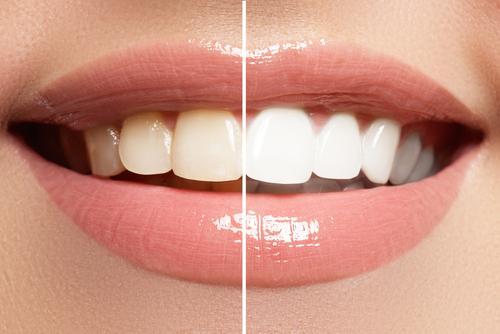Teeth whitening is one of the most sought-after cosmetic dental treatments worldwide. It’s an excellent option for removing all kinds of stains. However, the results are not permanent. If you’re not serious about oral hygiene, teeth stains may reappear after a bleaching procedure. This article will answer all your questions about teeth whitening.
Table of Contents
What Causes Teeth Stains?
Poor oral hygiene and all strong-colored foods and drinks such as coffee, tea, and alcohol cause yellow teeth the most.
Regular brushing and flossing removes a fine layer of food and bacterial debris that develops on your teeth. This layer, called the plaque, is the main reason behind tooth staining. Without proper oral hygiene, debris from strong-colored foods accumulates on the tooth surface over time and remains permanently. This results in staining of the teeth.
Can Yellow Teeth Become White Again?
The answer is yes, through teeth whitening. There are various ways to whiten teeth and remove surface stains.
What are the Popular Treatments and Terms for Teeth Whitening?
Teeth whitening is a procedure in which various methods remove surface stains from teeth. According to the Canadian Dental Association, the two commonly used whitening techniques are surface whitening and bleaching.
Surface Whitening
Surface whitening includes removing surface teeth stains using abrasives incorporated in the toothpaste.
Bleaching
Bleaching is done chemically by using a strong yet safe whitening agent – typically carbamide peroxide – that reacts with and removes surface stains. Teeth bleaching can be done by directly applying a whitening agent on the teeth or using whitening strips.
At-Home versus Professional Teeth Whitening
Teeth can be whitened at a dentist’s office or your home. The former is one you can do alone at home and the latter by teeth whitening dentists.
What are the Proven DIY Methods to Whiten Teeth at Home?
If you’re busy and don’t have the time to get your teeth whitened at a dental clinic, there are ways to do so in the comfort of your home. Some DIY techniques include:
At-Home Teeth Whitening Kits
You can use numerous teeth whitening kits at home. However, make sure to check whether they carry the seal of approval of the Canadian Dental Association or your local dental regulatory authority. Using a non-approved kit may cause more harm to your teeth than good.
Whitening Toothpaste
A toothpaste often contains abrasives that help remove surface stains. Whitening toothpaste should not be used frequently as it may cause the teeth to become sensitive.
Teeth Whitening Strips
These strips are loaded with a bleaching agent. When applied to the teeth for the specified duration, they will chemically dissolve the stains and lighten the shade.
How To Whiten Teeth Naturally at Home?
If you prefer natural methods, here are some safe options you can try at home.
1. Charcoal
Charcoal is a popular natural teeth whitening technique used at home. It works as an abrasive and removes a thin layer of the outer tooth enamel, revealing a fresh, pearly white layer. Due to its abrasive properties, use it carefully and only those CDA-approved charcoal-based whitening toothpaste.
2. Oil Pulling
Coconut oil pulling has also been used for whitening teeth. However, there’s currently no concrete scientific evidence available stating that swishing oil can whiten teeth.
However, a recent research study1 has shown that oil pulling can be used indirectly for whitening as it has anti-plaque properties that prevent the formation of plaque and tartar on the teeth, thereby minimizing the risk of tooth staining.
3. Teeth Whitening with Fruits and Vegetables
Fruits and vegetables have also been advocated as effective methods for whitening teeth. For example, many people use lemons and strawberries for this purpose.
These fruits and vegetables are mildly acidic. Once applied, they can chemically remove the surface stains.
However, don’t overuse them as they may damage the enamel and make your teeth sensitive and cavity-prone. Apple cider is also an effective and proven teeth-whitening option. Besides, recent research 2 showed that teeth whitening using strawberries was not as effective as professional whitening at the dentist.
4. Baking Soda
Using baking soda is a popular natural teeth whitening technique. Baking soda acts as an abrasive and physically removes teeth stains. Some toothpaste also incorporate baking soda as a whitening agent.
How Can I Regain My White Teeth?
If you previously had your teeth whitened but have become stained again, don’t worry. You can choose from various options to get back your pearly white smile. If the stains are mild to moderate, you can benefit from an at-home teeth whitening kit. However, if you have heavy teeth stains, it is best to undergo professional teeth whitening to enjoy the best aesthetic outcome.
Conclusion
Teeth whitening is an effective procedure to remove adherent teeth stains and restore one’s smile. However, it should not be considered a substitute for conventional oral hygiene measures such as brushing and flossing.
If you have teeth stains that affect your confidence and smile, you can get your teeth whitened using at-home kits or by one of the best dentists near you.
About the Author

Dr. Mehmood Asghar is a dentist by profession and an Assistant Professor of Dental Biomaterials at the National University of Medical Sciences, Pakistan. Dr. Asghar received his undergraduate and postgraduate dental qualifications from the National University of Science and Technology (NUST). He is also currently pursuing a Ph.D. in Restorative Dentistry from Malaysia. Apart from his hectic clinical and research activities, Dr. Asghar likes to write evidence-based, informative articles for dental professionals and patients. Dr. Asghar has published several articles in international, peer-reviewed journals.


 Home
Home










